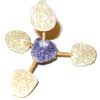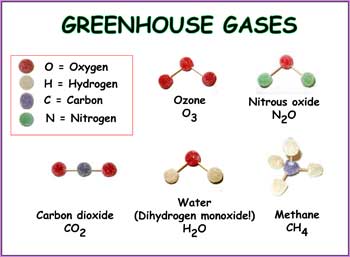Get your Gummy Greenhouse Gases!

Got gumdrops? Then you can build models of molecules. Molecules are tiny structures that make up just about all matter—including you! Molecules themselves are made of atoms, the basic building blocks of matter.
Using just four kinds of atoms as building blocks, you can construct many different types of molecules. In this project, you will build models of some gas molecules. These kinds of gas molecules are part of the air. They are called greenhouse gases. We will explain why later.
For now, get ready for some gummy fun!
You will need:
Gumdrops, any size, four different colors.
Round wooden toothpicks
Construction paper, 1 large sheet (12x18, for example)
Felt pen or crayons
These atoms are usually modeled using red for oxygen, white for hydrogen, gray for carbon, and blue for nitrogen. However, some of these colors are mighty hard to find in gumdrops. So use any colors you like. Here's how many you will need of each (but don't forget to get extras for sneaking into your mouth):
Red: 13
White: 7
Gray (or black): 3
Blue: 2
Here are the colors we used for our gumdrop building block atoms:

Oxygen

Hydrogen
Carbon

Nitrogen
You will make . . .
. . . Gummy Greenhouse Gas models of these gases. Each molecule has a shorthand name, which also gives its recipe, or formula. For example, ozone is also called O3, where O stands for an oxygen atom and the little 3 means there are three of them. Here are all the greenhouse gas molecules, their formulas, and a picture of its gumdrop model.
| Name of greenhouse gas | Recipe | Shortcut (formula) | Gumdrop model |
| Ozone | 3 oxygen atoms | O3 |  |
| Nitrous oxide | 2 nitrogen atoms and 1 oxygen atom | N2O |  |
| Carbon dioxide | 1 carbon and 2 oxygen atoms | CO2 |  |
| Water vapor | 2 hydrogen atoms and 1 oxygen atom | H2O |  |
| Methane | 1 carbon atom and 4 hydrogen atoms | CH4 |  |
Here's how:
Break several toothpicks in half. You will need only one-half a toothpick to make each "bond." The bonds are how the atoms are stuck together to make molecules.
Build each of the greenhouse gas molecules, as shown above.
Now, take the big piece of construction paper and your crayons or felt pen and label it something like this:
Place your molecules above their labels.

Comments
Post a Comment